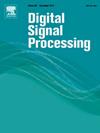Deep tensor completion graph convolutional subspace clustering
IF 2.9
3区 工程技术
Q2 ENGINEERING, ELECTRICAL & ELECTRONIC
引用次数: 0
Abstract
Graph Convolutional Subspace Clustering (GCSC) aims to integrate the topological information of data with subspace representations by Graph Convolutional Networks (GCNs). However, existing methods are limited by their emphasis on local topological information, which neglects global relationships in data. Also, their adjacency matrices are fixed and predefined, which fail to adjust to the changing features during training and may be easily affected by noise. To address these issues, we propose Deep Tensor Completion Graph Convolutional Subspace Clustering (DTC-GCSC). Firstly, we treat the initialized adjacency matrix as a trainable parameter, enabling its joint optimization with the model through a deep architecture. Based on this framework, we further incorporate global topological information by integrating conventional subspace clustering (CSC) into GCSC, extending local relationships to a global structure. Finally, to enhance the consistency between local and global information, we introduce a Tensor Nuclear Norm (TNN) constraint to enforce high-order correlations across them. Extensive experiments on multiple datasets demonstrate the superiority of our method over state-of-the-art approaches.
深度张量补全图卷积子空间聚类
图卷积子空间聚类(GCSC)旨在通过图卷积网络(GCNs)将数据的拓扑信息与子空间表示相结合。然而,现有方法的局限性在于它们强调局部拓扑信息,而忽略了数据中的全局关系。此外,它们的邻接矩阵是固定的和预定义的,不能适应训练过程中特征的变化,容易受到噪声的影响。为了解决这些问题,我们提出了深度张量补全图卷积子空间聚类(DTC-GCSC)。首先,我们将初始化的邻接矩阵作为可训练参数,通过深度架构实现与模型的联合优化。在此框架的基础上,通过将传统的子空间聚类(CSC)整合到GCSC中,进一步整合全局拓扑信息,将局部关系扩展到全局结构。最后,为了增强局部和全局信息之间的一致性,我们引入了一个张量核范数(TNN)约束来强制它们之间的高阶相关性。在多个数据集上进行的大量实验证明了我们的方法优于最先进的方法。
本文章由计算机程序翻译,如有差异,请以英文原文为准。
求助全文
约1分钟内获得全文
求助全文
来源期刊

Digital Signal Processing
工程技术-工程:电子与电气
CiteScore
5.30
自引率
17.20%
发文量
435
审稿时长
66 days
期刊介绍:
Digital Signal Processing: A Review Journal is one of the oldest and most established journals in the field of signal processing yet it aims to be the most innovative. The Journal invites top quality research articles at the frontiers of research in all aspects of signal processing. Our objective is to provide a platform for the publication of ground-breaking research in signal processing with both academic and industrial appeal.
The journal has a special emphasis on statistical signal processing methodology such as Bayesian signal processing, and encourages articles on emerging applications of signal processing such as:
• big data• machine learning• internet of things• information security• systems biology and computational biology,• financial time series analysis,• autonomous vehicles,• quantum computing,• neuromorphic engineering,• human-computer interaction and intelligent user interfaces,• environmental signal processing,• geophysical signal processing including seismic signal processing,• chemioinformatics and bioinformatics,• audio, visual and performance arts,• disaster management and prevention,• renewable energy,
 求助内容:
求助内容: 应助结果提醒方式:
应助结果提醒方式:


